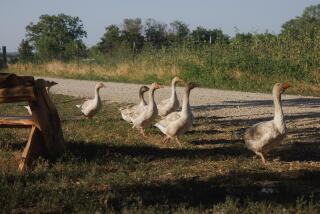Getting Ethiopia Back on Its Feet
- Share via
For many in the United States, “Ethiopia” will always be synonymous with “famine.” Americans remember TV images of starving children at feeding centers in the mid-1980s. In the past three decades, perhaps 2 million Ethiopians have died in periodic famines. But nearly 60 million of us are still living in a country that has favorable farming conditions and an ancient history of agricultural innovation. Our challenge is to reverse harmful practices of the past century that have prevented Ethiopia from feeding itself.
A major culprit is the decline of forests, which covered 40% of Ethiopia a century ago. Today, that figure is less than 4%. Deforestation has turned much of Ethiopia’s fertile crop and pasture land into dust bowls. Such were conditions in 1983-84, when failed harvests triggered the “Great Famine.”
But deforestation can be prevented and even reversed, as demonstrated by a World Vision project involving 50,000 people on 600 square kilometers in Ethiopia’s Ansokia Valley. Like much of the country, the 31-mile-long valley was thick with vegetation and animal life two generations ago. But a growing population needed trees for cooking, heat, fences and homes. Meanwhile, farmers cleared land for crops.
Relief workers arriving in 1984 described the Ansokia Valley as a “moonscape.” “The land was smoking, dust was everywhere, and there was no life in sight,” said one farmer. Like tens of thousands of others, he moved his family to a feeding center. Along with food, medicine and dollars, Western relief workers and their Ethiopian counterparts from Addis Ababa brought development expertise--as well as their own preconceived notions about farming--as they planned ways to overcome hunger permanently. Not only was Ansokia denuded of trees, but it also lacked roads and bridges. Public works projects began as part of relief efforts. To increase the tree cover, a large-scale nursery was started. Labor was provided by healthier adults in the feeding centers on a food-for-work basis. Hillsides were terraced to create new farmland and reclaim old. Dams and other water projects aided irrigation.
The principle behind agroforestry is as old as the Earth. Trees provide shade, fuel, wood, livestock feed and construction material. Leguminous trees fix nitrogen in the soil. Deep-rooted plants bring nutrients to the surface, rejuvenating the soil for crops and pastures surrounding the trees. Trees and cover crops prevent soil erosion and absorb standing water, which breeds malaria-carrying mosquitoes.
Fruits and nuts from trees add nutrients to the local diet not found in grains or meats. Having another source of food--and often income from surpluses--makes families less vulnerable when grain crops fail or animals die.
But in the first years, flaws emerged:
* Farmers did not feel ownership of the project, since the nursery was in a central location and belonged to World Vision.
* Cattle, starving due to eroded grasslands, grazed on seedlings.
* Ethiopian farmers considered tree species like pine exotic and uneconomical, preferring fast-growing eucalyptus, fruit-bearing papaya and nitrogen-fixing trees. Discouraged by years of drought and humiliated because they could not feed their children, they also felt incompetent when “outsiders” imposed new ideas. Their knowledge and time-honored systems had been pushed aside.
Working with farmers and government officials, development workers revised the program. Satellite nurseries sprang up, tended by local farmers who felt a greater sense of ownership. Guards were hired to keep cattle away from the main nursery. Tree varieties favored by local residents were grown.
A dozen years later, the area not only produces enough for its residents but also exports food to other regions. Nearly 10 million trees have been planted.
Farmers like Zeleke Shawel, 44, who received food aid during the Great Famine, acquired one acre in the town of Mekoy that had a history of flooding and erosion. “I really did not believe something would come out of those seedlings,” he admitted. Today, he has thousands of trees. The coffee and most of the fruit trees are cash crops. So are the eucalyptus, which can be used for lumber, fuelwood and cattle fodder. With $700 in profits, Shawel built the first hotel in Mekoy.
The project has increased the standard of living throughout the area. A food deficit of nearly 2,500 tons in 1990 became a food surplus of 6,352 tons in 1996. In addition, the child mortality rate now is 20% lower than the rest of the country. The land is covered with forests at twice the national average.
This success holds hope for other deforested areas. Applying lessons learned here, World Vision is supporting a similar effort at a second Ansokia site. Together, the two projects reach only one-third of the valley. The program could be expanded, using development aid and private investment.
The United Nations still rates Ethiopia as the world’s sixth-lowest country in terms of human development. But the reforestation of Ansokia gives one hope that Ethiopia one day will not be synonymous with “famine.”
More to Read
Sign up for Essential California
The most important California stories and recommendations in your inbox every morning.
You may occasionally receive promotional content from the Los Angeles Times.













